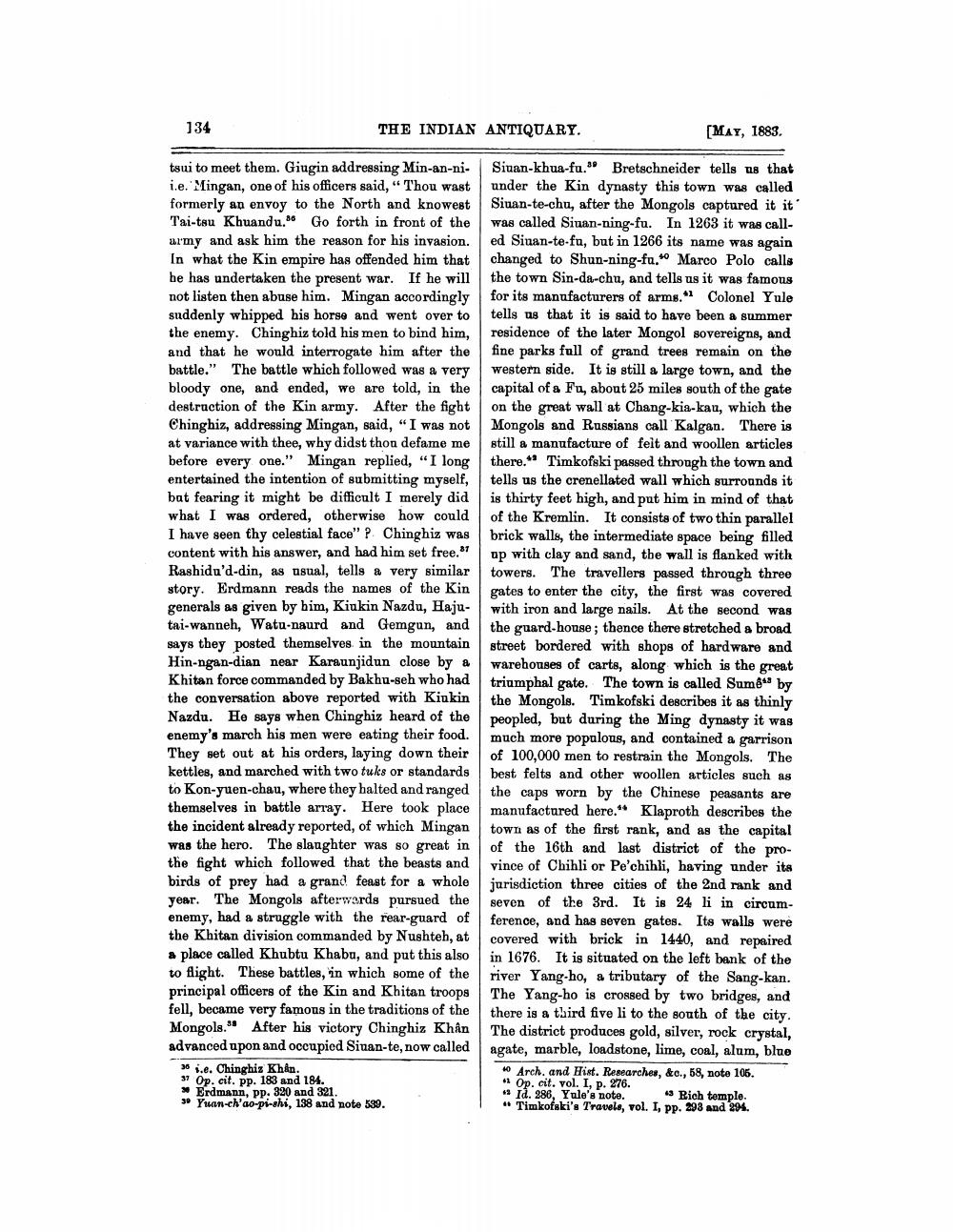________________
134
THE INDIAN ANTIQUARY.
[MAY, 1883.
tsui to meet them. Giugin addressing Min-an-ni. i.e. Mingan, one of his officers said, " Thou wast formerly an envoy to the North and knowest
Tai-tsu Khuandu. Go forth in front of the army and ask him the reason for his invasion. In what the Kin empire has offended him that be has undertaken the present war. If he will not listen then abuse him. Mingan accordingly suddenly whipped his horse and went over to the enemy. Chinghiz told his men to bind him, and that he would interrogate him after the battle." The battle which followed was a very bloody one, and ended, we are told, in the destruction of the Kin army. After the fight Chinghiz, addressing Mingan, said, "I was not at variance with thee, why didst thon defame me before every one." Mingan replied, "I long entertained the intention of submitting myself, bat fearing it might be difficult I merely did what I was ordered, otherwise how could I have seen thy celestial face" P. Chinghiz was content with his answer, and had him set free." Rashidu'd-din, as usual, tells a very similar story. Erdmann reads the names of the Kin generals as given by him, Kiukin Nazdu, Haju- tai-wanneh, Watu-naurd and Gemgun, and says they posted themselves in the mountain Hin-ngan-dian near Karaunjidun close by a Khitan force commanded by Bakhu-seh who had the conversation above reported with Kiukin Nazdu. He says when Chinghiz heard of the enemy's march his men were eating their food. They set out at his orders, laying down their kettles, and marched with two tuks or standards to Kon-yuen-chau, where they halted and ranged themselves in battle array. Here took place the incident already reported, of which Mingan was the hero. The slaughter was so great in the fight which followed that the beasts and birds of prey had a grand feast for a whole year. The Mongols afterwards pursued the enemy, had a struggle with the rear-guard of the Khitan division commanded by Nushteh, at a place called Khubtu Khaba, and put this also to flight. These battles, in which some of the principal officers of the Kin and Khitan troops fell, became very famous in the traditions of the Mongols. After his victory Chinghiz Khân advanced upon and occupied Siuan-te, now called
30 1.e. Chinghiz Khan. 37 Op. cit. pp. 183 and 184. * Erdmann, pp. 320 and 321. 30 Yuan-ch'ao-pi-shi, 138 and note 539.
Siuan-khua-fu." Bretschneider tells us that under the Kin dynasty this town was called Siuan-te-chu, after the Mongols captured it it was called Sinan-ning-fu. In 1263 it was called Sinan-te-fu, but in 1266 its name was again changed to Shun-ning-fu.“ Marco Polo calls the town Sin-da-chu, and tells us it was famous for its manufacturers of arms." Colonel Yule tells us that it is said to have been a summer residence of the later Mongol sovereigns, and fine parks full of grand trees remain on the western side. It is still a large town, and the capital of a Fu, about 25 miles south of the gate on the great wall at Chang-kia-kau, which the Mongols and Russians call Kalgan. There is still a manufacture of feit and woollen articles there." Timkofski passed through the town and tells us the crenellated wall which surrounds it is thirty feet high, and put him in mind of that of the Kremlin. It consists of two thin parallel brick walls, the intermediate space being filled brick walls, the intermediate ana up with clay and sand, the wall is flanked with towers. The travellers passed through three gates to enter the city, the first was covered with iron and large nails. At the second was the guard house; thence there stretched a broad street bordered with shops of hardware and Warehouses of carts, along which is the great triumphal gate. The town is called Sumê" by the Mongols. Timkofski describes it as thinly peopled, but during the Ming dynasty it was much more populous, and contained a garrison of 100,000 men to restrain the Mongols. The best felts and other woollen articles such as the caps worn by the Chinese peasants are manufactured here.** Klaproth describes the town as of the first rank, and as the capital of the 16th and last district of the province of Chihli or Pe'chihli, having under its jurisdiction three cities of the 2nd rank and seven of the 3rd. It is 24 li in circumference, and has seven gates. Its walls were covered with brick in 1440, and repaired in 1676. It is situated on the left bank of the river Yang-ho, a tributary of the Sang-kan. The Yang-ho is crossed by two bridges, and there is a third five li to the south of the city. The district produces gold, silver, rock crystal, agate, marble, loadstone, lime, coal, alum, blue
0 Arch, and Hist. Researches, &c., 58, note 106. *1 Op. cit. vol. I, p. 276. * Id. 286, Yale's note.
Rich temple. * Timkofski's Travels, vol. I, pp. 298 and 294.




